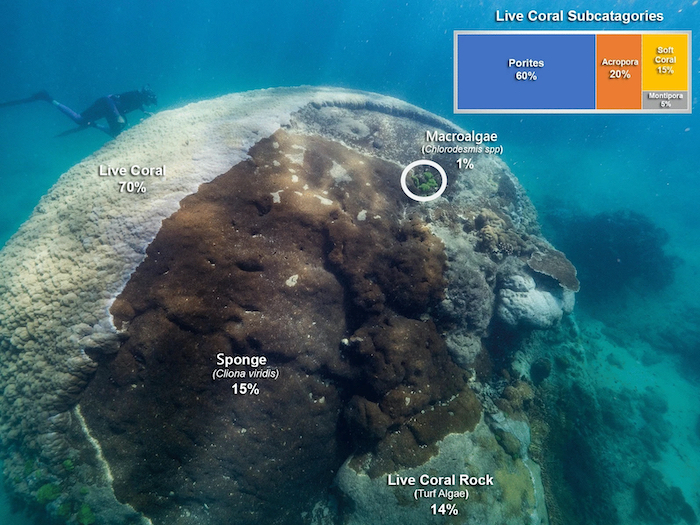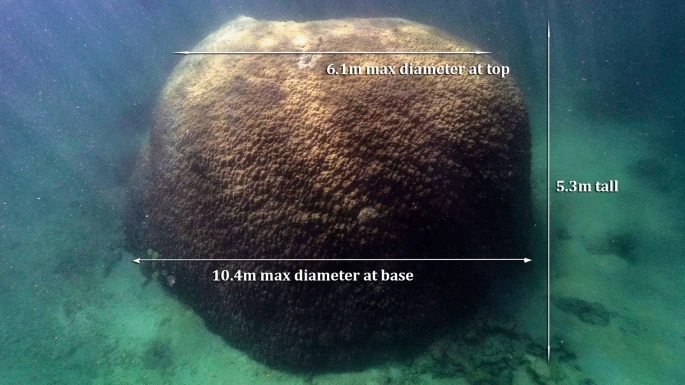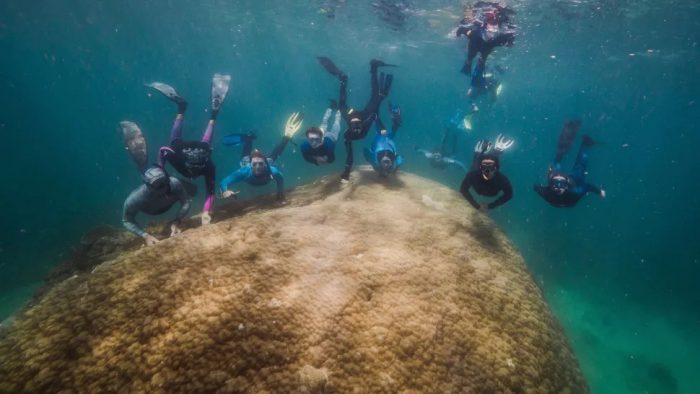The Great Barrier Reef is an immense natural work of art. Home to billions of creatures. Full of vibrant colours and biodiversity. And so massive, this ocean feature off the eastern coast of Australia, is actually visible from space.
So it's no real surprise that one of the biggest corals ever seen has been found right here. (Though it IS maybe shocking that it was only just found!)
May we introduce you to Muga Dhambi—a 400-year-old coral colony that is about twice as large as an African elephant. Meaning 'big coral' in the Indigenous language of Manbarra, this giant living structure was here long before the first European explorers reached the Australian continent.
What an amazing survivor!
What is a coral colony anyway?

Because it is so long-lived, Muga Dhambi is a collection of a few organisms. Though mostly a coral colony, its structure also has a large sponge and patches of algae. (Nature/Creative Commons)
You may have noticed that we called Muga Dhambi a coral colony, not just coral. Is that because it's so big?
The answer is no. Almost all corals are actually a colony, or a connected group of animals. Each one is made up of many millions of tiny, identical creatures called polyps. These polyps live and 'work' together to survive, joined to each other by either flexible tissue (soft corals) or a rigid skeleton made of calcium carbonate (stony corals).
The corals get their energy thanks to symbiotic (helpful to both living things) relationship with photosynthetic algae. Like plants, these algae make food by using the energy of the Sun. This energy is then passed on to the polyps, and the coral colony grows and thrives!
A long time to grow

The impressive measurements of Muga Dhambi. (Nature/Creative Commons)
In the case of Muga Dhambi, it really has grown and thrived over the years. A coral skeleton is built slowly over time, using minerals found in seawater as materials. For a stony coral to reach the size of this one—as much as 10.4 m (34.1 ft) by 5.3 m (17.4 ft)—you need a lot of time. This makes Muga Dhambi's enormous skeleton a living record of hundreds of years of history of the Great Barrier Reef. (Kind of like how layers of sedimentary rock tell the history of the Earth and creatures that lived in a particular area.)
Unfortunately, not all news lately about the Great Barrier Reef has been great. For many years now, high temperatures due to climate change have caused coral bleaching. This makes the polyps in a coral to reject their algae. The colony temporarily loses colour, and stops getting food. If it goes on too long, the coral dies, leaving behind only its empty skeleton.
So far, Muga Dhambi has survived heat waves, cyclones, predators, and all kinds of other natural threats to become one of the greatest corals ever known. Hopefully, it has many more years to go, too. But much of that will depend on how climate change is addressed.
 Researchers from Reef Ecologic, who studied the coral, show us all the incredible size of Muga Dhambi. (Richard Woodgett/Grumpy Turtle)
Researchers from Reef Ecologic, who studied the coral, show us all the incredible size of Muga Dhambi. (Richard Woodgett/Grumpy Turtle)









